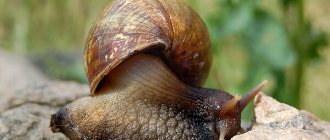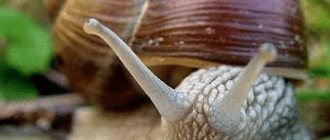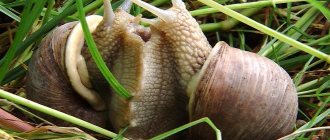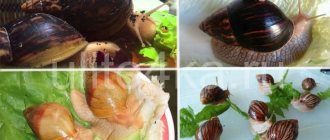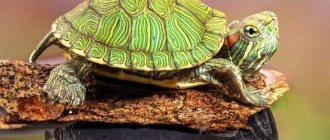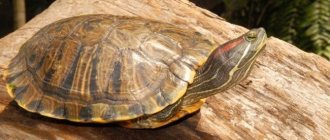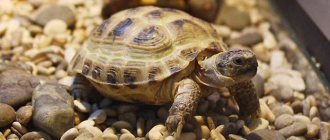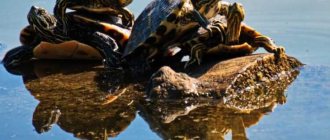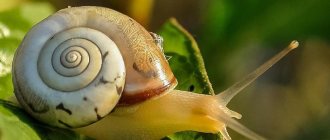You won’t be surprised by snails in a home terrarium. Completely different mollusks become pets - helix, chains, Achatina, Limicolaria, Caracolius and many others. But, in order for your pet to actively grow and feel healthy, it needs to create certain conditions. Anyone who wants to get such an exotic pet should choose a representative of an unpretentious and hardy species as their first snail. And only after a successful experience should you get a more capricious mollusk. We will talk about one of these species, which is suitable for beginner snail breeders, in our article. This is the Achatina Fulik snail.
Description
The homeland of Achatina fulica is East Africa, its range has spread to other continents. In some countries, keeping and breeding snails is prohibited. Representatives of the fulica species have different colors: the shell is light or brown with a yellow or reddish pattern. The shell is conical in shape and consists of 7–10 whorls. The body can be light, yellowish and dark. There are 4 tentacles on the head: the long ones serve as eyes, the short ones serve as a sensory organ that helps to perceive odors. The sense of smell is well developed.
Size
The maximum size of an adult is 35 cm in length and 15 cm in width. Shell up to 15–20 cm. Weight up to 600 g.
Behavior
The active period of Achatina fulica occurs at night; the snails feed and crawl along the walls of the aquarium. During the day, mollusks sleep, hiding in a shell. Adults are less mobile than young ones. Snails are capable of covering long distances. They are not a gregarious species; communication between individuals occurs during mating. The olfactory organs play a major role in the perception of the surrounding world.
Life cycle
Sexual maturity occurs at 6–15 months. Achatina fulica is a hermaphrodite. A minimum of two individuals are required for mating. A large snail acts as a female. Self-fertilization is possible in rare cases when the population is low. A fertilized snail can produce offspring over the next 2 years. There are 200–300 eggs in one clutch, which Achatina can lay every couple of months. Achatina fulica grows actively for 2 years, then growth slows down. They do not need to hibernate.
How long do they live?
Representatives of the Fulika species live up to 10 years with good care.
View this post on Instagram
Posted by mollie (@mollierosepowell_) Jan 3, 2021 at 1:03 am PST
Achatina fulica Bowdich, 1822
The content of the article:
The most commonplace or the most famous? What's in your name? General view A little about the sizes What's on sale? Who is the “godfather”? One species – many names Subspecies or forms? Error with “hemeli” “Left-sided” fuliki, or a few words about “royal snails” And something else Distant wanderings (literary quote) History in dates What happened then Snails against snails
The most commonplace or the most famous?
Without a doubt, Fulica is now the most common and famous species of Achatina. Moreover, it is widespread both in natural conditions (largely thanks to people; see a more detailed story about this below) and in amateur terrariums. Unpretentious, prolific, most often ending up in pet stores and, alas, in random, not always caring hands. It was with her that many experienced snail breeders began their acquaintance with the wonderful world of tropical snails. We are no longer talking about newspapers and other media: there, the word “Achatina” (options: “Achatina”, “Achatina snail”, “giant snail”) almost always means Achatina fulica.
What's in your name?
Not only Achatina, but also many other exotic (that is, not found in our area) mollusks often either do not have Russian names at all, or they are used only occasionally. Most often, snail breeders use transliteration of Latin names to designate different species, when the scientific Latin name is written in Cyrillic letters. Yes, Achatina fulica
called "Achatina fulika" or, for short, simply "fulika". And few people think about what this combination of words means.
Firstly, “Achatina”. Derived from the Greek word "achates", which means "agate". In German, Achatina is also called “Achatschnecken”, translated as “agate snails”. In Russian-language popular science literature, the expression “agate snails,” by the way, also appears, but rarely. Moreover, we usually call small domestic snails from the genus Cochlicopa
(family Cochlicopidae).
The word “fulika” is no less interesting. Looking at the Latin-Russian dictionary, you can find out that “fulica” is a coot, a water bird with black plumage and a leathery “plaque” above the beak, similar to a bald patch. In general, the origin of this word is associated with the color black. And not just black, but “black as soot.” Perhaps the fulica (a snail, not a bird) was named so because with age, the shell whorls it completes become darker. True, the body, or more precisely the leg, of these snails can be quite dark. But the body color of land snails is generally very variable, therefore, when describing new species (or forms), they usually do not pay attention to it, unlike the shell. And in the first half of the 19th century, descriptions of species (and forms) in general often took place based on single empty shells stored in collections, often even without exact labels or with incorrectly indicated collection sites.
Fulica is also sometimes called the East African Achatina or the East African giant snail. This is due to its original (natural) distribution.
General form
Actually, we will not describe in detail the appearance of Achatina fulica
, because different color forms and age stages can be seen in the photographs we collected and shown just above. Let us dwell only on some details that allow us to distinguish this snail from other species of Achatina.
Typically, the shell color changes as the snails grow. Or rather, the nature of the coloring of the revolutions it completes changes. Earlier (smaller) whorls cannot change color, except that the uppermost and thinnest stratum corneum (periostracum) may gradually peel off from them. Snail eggs hatch with very small, fragile, translucent shells, light in color and without a pattern. On later whorls, a dark (brown, in contrast with the light background of the shell can look almost completely black) pattern of clearly visible transverse stripes most often appears. With age, there are more and more dark areas on the shell, and fewer and fewer light areas. As a result, the last one or two (largest) whorls no longer look striped, like in “teenage” fuliks, but are almost uniformly brown, often with a greenish tint.
This is how the color of the shell of a “typical” fulica, which snail breeders call “standard,” changes with age. Sometimes a dark pattern does not appear on the shell, but the shell remains light - yellowish. More precisely, the calcareous base of the shell is white, but the thin stratum corneum covering it (periostracum) can have different shades of yellow. Such shells are often called “albino”, although this is not entirely true. After all, albinism is a complete absence of pigment.
To identify different species of Achatina and their relatives, Achatina, the color of the columella can be important. The columella is a column formed by the touching inner walls of the shell whorls. It can be thought of as the internal axis of the shell, running from its apex to the mouth. In Achatina and their closest relatives, the shell is designed in such a way that the lower end of the columella is visible on the left side of the mouth (in snails with a left-handed shell, on the right side). In fairly large snails, not only the columella itself, but also the areas adjacent to it, are painted the same color (in the fulica - white or bluish-white).
Shell of an adult snail: 1 – lower end of the columella (the main part of it is inside the shell and is not visible), 2 – influx (callus), colored to match the columella.
For comparison, the shells of young snails
A little about sizes
Fulica is often mistakenly called the largest land snail in the world. Journalists are especially guilty of this. In fact, in terms of shell size (and this is how snails are measured), the fulica is noticeably inferior to its larger relative, the common Achatina Achatina achatina
.
What size can a fulica shell reach? Further we will only talk about the length of the shell.
Firstly, how large can snails of this species grow in natural conditions? Let's look for the answer in the review scientific work Bequaert JC Studies in the Achatininae, a group of African land snails // Bulletin of the Museum of Comparative Zoology at Harvard College. – 1950. – Vol. 105, No. 1. – P. 4–216, pls. 1–81.
Of the 33 measured shells of adult (sexually mature) individuals, collected in different places outside the African continent, where Achatina were brought at different times by people (we will talk about this in more detail a little later), the smallest was 72 mm long, the largest - 171 mm . In Africa itself, the same picture was observed: normally colored shells had a length from 73 mm to 162 mm (28 pieces measured), yellow shells without a dark pattern - from 98 mm to 148 mm (11 pieces measured). JCBequaert also mentions literary data on finds of individuals of this species with shells reaching a length of 178 mm and even 190 mm. Thus, under natural conditions, the largest individuals of Achatina fulica
The length of the shell can reach 17, 18 and even 19 cm.
What about in a terrarium? Of course, the size of the shell depends on the genes, and on the conditions of detention (especially in the first months of life), and on how early the snails are “allowed” to reproduce. I.S. Krasnov in his popular brochure “Giant snails - Achatina. Experience of successful keeping and breeding at home" (Moscow: Aquarium-Print LLC, 2008) indicated the shell length of the largest fulika that lived with him - 15.5 cm.
And here are photographs of the most prominent giants among the Fulics, kindly provided by our snail breeder friends. On the first of them are two snails of Irina Beskorovainaya. The eldest, named Tank, at the age of 2.5 years, grew a shell 17 cm long, her descendant (Podlyana Tankovna) at the age of 1 year and 2 months grew to 15 cm.
And another giant (owner Natalia Devyatykh). Judging by the photo with the ruler, the length of the sink is almost 19 cm!
What's on sale?
Snail breeders now actually distinguish 4 varieties (and in fact, color forms of this species). Sometimes they are mistakenly called subspecies, although they have nothing to do with real subspecies (we will explain why below).
1) “Standard” - a snail with a usually colored shell and body. 2) “Albino”, “albino body” - snails with a white body and a normally colored shell. This combination of light body and dark shell is also called “White Jade”. A white body is an inherited recessive trait, a normally (standard) colored one is a dominant one. 3) “Rodatsi”, they are also “rodatsiy”, “rodashki”, var. rodatzi
- snails with a normally colored body and a yellow shell without a brown pattern.
Such a shell is an inherited recessive trait, while a normally colored shell is a dominant one. 4) “Rodatsi albino”, “Rodatsi albino body” - snails with a white body and a yellow shell (combination No. 2 and No. 3). 5) “Hemeli”, var. hamillei
is the common name given to snails with a pink apex, although this is incorrect. But we will talk about this a little below. 6) “Hemeli rodatsi” is an erroneous name for snails whose shell is yellow, but with a pink (or at least pinkish) top.
Who is the “godfather”?
We have already talked above about why the fulika was called fulika. But the question is who is officially considered her “godfather.” All currently known species of animals (and not only animals) have a Latin name, consisting of the name of the genus and the name of the species. After these two words, they usually indicate the surname of the person who first gave a scientific description of this species and assigned its Latin name, and the year when this happened. But with fulica, the matter is a little confusing: even in scientific publications it is called Achatina fulica
(Férussac, 1821), then
Achatina fulica
Bowdich, 1822. Formally, it seems clear: 1821 was earlier than 1822, and the “godfather” of fulica is the French baron and “part-time” famous malacologist d'Audebard de Férussac ( after which, by the way, the small half-slugs Daudebardia are named). You are wrong!
Now, in order to describe a species of mollusk unknown to science, a scientist must comply with a number of formalities: describe in a scientific journal at least the appearance of its shell (and preferably the structure of the reproductive system), provide images (drawings or photos) of typical specimens, indicate in which museum or they are located in another public collection, where and when they were collected, how the new species differs from related (similar) species, why it was given such a Latin name (what it means). Once upon a time there were no such strict rules. A scientist could simply depict a shell in some work, signing it with a new Latin name. Or, conversely, give a name and a short verbal description, from which little is clear at all, without an image.
Let's return to our fulika. Helix fulica lives on the island of Mauritius (where people brought the fulica - see below)
(don’t be surprised that Helix, and not Achatina, once upon a time many land snails were classified specifically in the genus
Helix
). But he gave neither a description of this species, nor even an image of its shell. That is why many modern researchers consider the instruction of the French baron to be “nomen nudum”, i.e. an empty, “naked” name.
Bowdich went a little further in 1822. He gave an image of the shell Achatina fulica
(already Achatina, not Helix), but “forgot” to indicate the place of collection and give at least a brief verbal description of the species. And even the very authorship of this species was mistakenly attributed to Lamarck. The famous Achatina researcher JCBequaert (1950) suggested that the depicted shell also comes from the island of Mauritius.
By the way, Lamarck himself, in the same 1822, described the same fulica from Mauritius, but under a different name - Achatina mauritiana
, i.e. Mauritian.
One type - many names
Look at any type of large tropical (Achatina, Archatina, Caracolus) or domestic (Helix, Chainea, etc.) snails. You will immediately see that even among representatives of the same species, shells can differ greatly in size (of course, we are talking here about the size of adult snails, and not about growing babies), shape, and especially color. It is not surprising that scientists once described many forms (f.), varieties (var.), subspecies and even individual species, which upon closer examination turned out to be simply synonyms.
If we talk only about species, the same fulica was first described from island specimens (see above) as fulica and as mauritiana (1821-1822), and only much later from its native African continent as Achatina rodatzi
Dunker, 1852 (individuals with a yellow shell) and
Achatina hamillei
Petit, 1859 (individuals with a typically colored shell).
There was also Achatina castanea
Lamarck, 1822, described from nowhere (but we will talk about this form a little later). We won’t even mention other names and forms here. Anyone interested can look at the lists of synonyms in the work: Bequaert JC Studies in the Achatininae, a group of African land snails // Bulletin of the Museum of Comparative Zoology at Harvard College. – 1950. – Vol. 105, No. 1. – P. 4–216, pls. 1–81.
Subspecies or forms?
So, by the middle of the twentieth century, too many names had already accumulated in the scientific literature, under which different authors described or simply indicated the same fulika. The already mentioned above JCBequaert (1950), having studied in detail literary sources and collection materials, left only (!) 5 names, tentatively calling them “subspecies”. True, with the caveat that some of them have not been sufficiently studied and therefore can later be reduced simply to synonyms for “typical fulika.” Actually, the scientist retained these names not even because he himself considered them all to be real subspecies, but simply made “a concession to prevailing practice and in order to prevent them from being described again under some new names.”
Here it is necessary to explain what a subspecies is from the point of view of modern biology. Most often, subspecies is a geographical concept. When a species has a sufficiently large area of habitat (habitat), the possibility arises that in some part of this range (especially if it is partially or completely isolated from other areas inhabited by the same species) some characteristics will arise and spread (for example, a special shape or color of a mollusk shell) that is not found elsewhere. However, these signs should not only be found in a given territory; individuals with such signs should make up, if not 100%, then at least 75%. And, accordingly, similar specimens should not be regularly found in other parts of the species range.
Different subspecies cannot live in the same territory without “mixing” with each other. Despite some external differences, they remain representatives of the same species, so they can freely interbreed and produce fertile offspring. And therefore, where territories inhabited by different subspecies come into contact, more or less wide hybrid zones (hybridization zones) are formed. Here you can see everything - both specimens resembling “pure” subspecies, and a variety of “crossbreeds”.
In principle, partial ecological isolation of subspecies is also possible - when they are found in the same territory, but under very different environmental conditions. But this phenomenon is much rarer than geographic isolation. And we don’t know whether it occurs at all in terrestrial mollusks. It should also be noted that even many species with very large ranges have no subspecies at all.
If in one place we see snails with more “slender” and more “pot-bellied”, white and brown, yellow and pink, striped and stripless shells (this list goes on and on), which live “in one big and friendly family,” they interbreed with whomever they want (or, more precisely, with whomever they have to), and at the same time the different forms do not disappear, do not “mix” into one amorphous mass, we are definitely not looking at subspecies. These are genetically determined forms such as our blondes and brunettes, people with gray, brown or black eyes, etc. If we ignore the tropics and look at our temperate latitudes, the colonies of the forest chain Cepaea nemoralis
or garden chain
Cepaea hortensis
.
Let us return to the “subspecies” of fulica, which were left “for purely nomenclature reasons” by JCBequaert (1950). And we will explain why they cannot be called real subspecies from the point of view of modern zoology and zoological systematics. So, 5 “subspecies”.
1) “Typical” Achatina fulica
- the scientist attributed to it almost all snails living outside of Africa and having a typical shell color. The fact is that fulica comes from East Africa. Once upon a time it was brought by people to Madagascar, from there it came to the Mascarene Islands, and from there further until it “occupied” many tropical islands (and not only islands).
Well, there seems to be isolation here, but did the snails taken from Africa have enough time to form a new subspecies? Do they have any distinctive features that distinguish them from African Fulikas?
JCBequaert mentions only slightly smaller sizes and some differences in the shape (proportions) of the shells. However, the sizes of both African and island fulikas practically overlap. On average, the length of the shells of mature snails studied by the researcher was about 110 mm in the first case and 124 mm in the second (the difference is less than 1.5 cm).
Now about the shape (proportions) of the sink. J. C. Bequaert notes that the island fulicas have a somewhat more slender shell, and the last whorl and aperture are relatively shorter than those of their African relatives.
Between you and me, such changes in shell proportions may well be associated with slightly smaller sizes, and smaller sizes with a high density of colonies, which species introduced to new territories usually demonstrate, especially in the first time after introduction.
In any case, JCBequaert himself notes that only the “extreme” variants of both “races” (i.e., island and African) are well distinguished, but it is possible to select shells that are absolutely identical in shape and size.
2) “Subspecies” Achatina fulica castanea
Lamarck, 1822
was described by Lamarck generally as a separate species Achatina castanea
. Either one or several shells (one type specimen is kept in the Geneva Museum), collected in an unknown location (!). A distinctive feature is the two-colored last whorl of the shell: the lower half is a beautiful chestnut color, the upper half is paler, reddish brown.
However, JCBequaert himself notes that he saw a tendency for the last whorl to be divided into two zones of contrasting color in “typical” fulicas from different island habitats. So here, too, the “subspecies” clearly does not stand up to criticism. And there is a certain color variation, obviously quite rare, but not “tied” to any particular area.
3) “Subspecies” Achatina fulica coloba
Pilsbry, 1904
– described as a variety (var.) of fulica.
According to several shells (two from adult snails, one from a young one), collected from an unknown location. JCBequaert saw two type specimens incorrectly labeled "West Africa" (Fulica is an East African species). The shells had the same shape, color and sculpture as ordinary fulicas, differing only in their unusually small sizes - 54 and 58 mm (i.e. less than 6 cm) in two adult snails. Thus, another “subspecies” disappears, only a few undergrown snails remain. Of those that snail breeders would probably call “genbred” or “non-growing”.
4) “Subspecies” Achatina fulica hamillei
Petit, 1859
– described as a separate species from Africa.
It has the same shell color as the “typical”, “island race” of the Fulica (for details, see number 1). 5) “Subspecies” Achatina fulica rodatzi
Dunker, 1852
- described as a separate species from the Zanzibar Archipelago (a group of islands off the east coast of Africa).
In fact, this is simply a special color form of the shell, found in other parts of the African continent, and together with typically colored specimens. The white shell is covered with yellow periostracum (the upper thin stratum corneum). As would be expected, snails with such a light-colored shell are more often found in dry or even semi-desert parts of the species' range (Bequaert, 1950). This is understandable: the lighter the shell, the less it absorbs the energy of solar radiation, the less the shell and the snail’s body located in it overheat, the less moisture evaporates, the less the danger of dehydration and death. Consequently, “rodatsi” is not a subspecies. If desired, such snails with a yellow shell can be called Achatina fulica
var.
rodatzi
, but in no case
Achatina fulica rodatzi
.
This is how out of the five “subspecies” we don’t have a single real one left. And only one single and “indivisible” (at least for now) species of Achatina fulica with variable sizes, shape, proportions, shell color (and body color too, but only snail breeders are interested in the body color of snails, not scientists).
Error with "hemeli"
Ask a snail breeder what “hemeli” or “fulica hemeli” looks like, he will immediately remember the pink top of the shell (apex). In some cases, it will add something else about a more colorful shell. And he will be wrong. In the original description of Achatina hamillei
Petit, 1859 does not mention the color of the apex at all. And JCBequaert (1950) writes only that the uppermost (embryonic) shell whorls of the type specimen were broken off.
Moreover, JCBequaert uses the name hamillei to designate almost all fulicas living on the African continent (except, of course, those that have yellow shells without brown pigment - var. rodatzi
). Moreover, on page 86 he writes that in hamillei the embryonic whorls (the uppermost and smallest ones with which the snails hatch from the eggs) and the early postembryonic shell whorls (which are completed shortly after hatching) are usually (!) white or yellowish. white. And only in a series of shells of different sizes (and ages) collected in Zanzibar (an archipelago off the east coast of Africa), the researcher saw intense pink tops (down to the sixth whorl).
The “more variegated shell” is also not mentioned anywhere.
“Left-sided” snails, or a few words about “royal snails”
And about one more error floating around the Internet. And on some Russian-language sites, and even in the English-language Wikipedia, you can find such a “subspecies” of fulica as sinistrosa
Grateloup, 1840. In Russian-language Internet resources, for some reason such snails are sometimes called “royal”.
In fact, this is not a subspecies, not even a color form like “rodaci”. These are single, very rare mutant specimens in which the shell whorls are twisted in the opposite direction. Such “uniques” can occasionally be observed in a variety of species of snails, not only land ones. Due to the fact that all the organs of the reproductive system in such snails are also located on the wrong side, they usually cannot mate normally with normal relatives and leave offspring. But their shells (like a great curiosity) are naturally very much valued by collectors. On the Internet you can see photographs of several such left-handed shells Achatina fulica
.
But on the website ahatin.ru, next to a photograph of such a left-handed shell, for some reason they mistakenly placed a photo of six teenage fulikas with very beautiful and colorful, but completely normal, right-handed shells! From here this photo went “for a walk” on the Russian-language Internet.
And something else
Snail breeders sometimes also mention umbilicata (translated from Latin - having the shape of a navel), well, this is generally just a clumsy shell, possibly formed due to some kind of mechanical deformation during the growth of the shell https://www.femorale.com.
There is also rufescens (translated as blushing), so named, apparently, because of the reddish-brown stripes.
Far Journeys (literary quote)
He spoke very interestingly about how Achatina fulica
“conquered” various tropical and subtropical countries by the famous popularizer of zoological science
I.I. Akimushkin
in the book “Animal World”.
Below we present a slightly shortened version of his story entitled “Achatina’s Around the World Trip”
:
“Having set out from Africa, by 1950 Achatina had already walked half around the globe... No one knows how Achatina got to Madagascar. In 1803, she was found 700 miles from Madagascar - on the Mascarene Islands. But she had not yet had time to really proliferate here, and was rarely encountered. Therefore, the governor of the French island of Reunion preferred to import these snails from Madagascar. The fact is that the governor’s wife suffered from tuberculosis, and it was believed that snail soup was a good cure for it.
In 1847, shellfish explorer Benson saw giant snails here and liked them so much that he took some with him to India when he left. In Calcutta, the snails escaped from Benson’s room, took root well in the surrounding forests, multiplied and moved on.
At the beginning of our [twentieth] century they reached Sri Lanka. And in 1928, they ate up the plantings of rubber trees in Malaya... Two years later, Achatina crawled already in the gardens of Singapore. A year later they crossed the Chinese border, and in 1935 and 1936 tree branches in Java and Sumatra bent under their weight. The Second World War began here. Japanese military leaders decided that huge snails like Achatina could serve as excellent food for their soldiers. The snails were brought to the Mariana Islands and released into the forests. Snails ate plants - the Japanese ate snails. When the Americans landed here at the end of the war, the plantations of Saipan and Guam were literally swarming with soft-bodied goliaths. There were many of them on other islands of the Pacific Ocean, for example, on Hawaiian ones.
Connoisseurs were not particularly surprised when one fine morning a report came that giant snails were entertaining crowds of onlookers in the gardens of San Pedro, California ... "
History in dates
To clarify a little the history of the spread of fulica and show the scale and speed of this process, let’s turn from a popular science book to a more serious scientific work about Achatina: Bequaert JC Studies in the Achatininae, a group of African land snails // Bulletin of the Museum of Comparative Zoology at Harvard College. – 1950. – Vol. 105, No. 1. – P. 4–216, pls. 1–81.
So, the original (natural) distribution area of this species is the coastal part of continental East Africa between approximately 7 degrees north latitude and 17 degrees south latitude, and inland extending for a distance of 150 to 500 miles (i.e. from 240 to 800 km) . Also included in the natural distribution area are small islands located along the coast, for example, the Zanzibar archipelago (group of islands). But to Madagascar, also located near the eastern coast of Africa, fulica was most likely brought by people. No one knows exactly when this happened. It is only known that in the 1760s. Achatina have been found in several places in Madagascar. Judging by the descriptions, these could be two species at once - Achatina fulica
and
Achatina panthera
(synonym
A. immaculata
). The subsequent history of the Fulika "invasion" of various regions is described more accurately.
1760–1770s – in studies of land snails on the island of Mauritius (Mascarene Islands), Achatina have not yet been discovered
1803 - the first literary mention of the presence of phulica on the island of Mauritius (Mascarene Islands). Local residents told a story about the sick wife of the governor (quoted by Akimushkin - see above), for whom, on the advice of a doctor, a large number of Achatina were brought from Madagascar. The medicinal diet did not help the governor’s wife; she soon died, but the snails survived, spread across the island and soon became a real disaster for the people inhabiting the island.
1820s – information about the presence of fulica on Reunion Island (also Mascarene Islands) has been published.
1840 – snail found in the Seychelles.
1860 - the first literary mention for the Comoros Islands.
April 1847 - several snails were brought by Benson from Mauritius to India and released in the garden of the Asiatic Society of Bengal, near the city of Calcutta.
1848 - several snails from Calcutta were transported (by another person) to the city of Mussoorie (or Mussoori) located in the foothills of the Himalayas.
1910 – message from Ceylon (now Sri Lanka). The snails were discovered near the city of Kalutara in the southwestern part of the island.
Around 1921 - brought to the island of Sumatra.
1922 - Fulica was observed in several places on the Malay Peninsula and in Singapore. It is believed that it could have entered this region starting in 1910 or 1911.
1925 - brought to Japan. Later, fulika was brought to Japan several times, but due to climatic conditions, it was able to take root only in Okinawa. In 1945, the Americans who landed on this island found the fulica very common there.
Around 1928 - brought to the island of Borneo (aka Kalimantan).
1931 - introduced to southern China near the port city of Xiamen (Xiamen, formerly Amoy).
January 1932 – brought from Singapore to Formosa (the colonial name of the island of Taiwan). In 1941 it was already very common in cultivated areas of the island.
Late 1932 or early 1933 - found on the island of Java.
1936 - first known find on the Hawaiian Islands. It is believed that the numerous Achatina colonies on the island of Oahu are descendants of two (in total!) snails brought to Honolulu from Taiwan in 1936. In November of the same 1936, 12 snails were imported from Japan to Makawao (the name of the area on the island). ve Maui).
1937-1938 – reached Siam (Indochina).
1938 - brought from Japan to the Palau archipelago, and later to the Mariana Islands (Saipan, Tinian, Rota, etc.).
Around 1941 - transported from Xiamen (see above) to Hong Kong.
1943-1945 – brought from Taiwan to the Philippines during the Japanese occupation.
1946 - accidentally brought from the island of Saipan (Mariana Islands) to the island of Guam (also Mariana Islands). Just a year later it spread throughout most of the southern half of the island.
1946 – report of the discovery of this species on the island of New Guinea.
1948 - the same on the Bismarck Archipelago, formerly called New Britain
1946 or 1947 - Several live snails were found in the gardens of San Pedro (California). It is believed that they were brought from some islands in the Pacific Ocean. The discovered snails were quickly destroyed, and the Department of Agriculture took measures to prevent further imports. As a result, snails were found on several more warships returning from the Pacific Islands.
Summarizing this historical excursion, JCBequaert emphasizes that fulika was transported by people from place to place most often deliberately, only in a few cases by accident. In addition, all later introductions can be traced, ultimately, to the primary introduction of this species to Madagascar and then to Mauritius.
What happened next
We will not bore readers with a detailed description of the further “exploits” of the Fulika. Two decades later, the American state of Florida suffered greatly from an invasion of snails of this species. There is such a version: in 1966, an American soldier from Miami, after finishing his service in the Hawaiian Islands, brought home and released three snails in his garden. And already in 1972, the authorities of the state of Florida spent about 300 thousand dollars on the fight against Achatina. For example, V. Ershov talks about this in his fascinating book “The Enchanting World of Shells”. By the way, the fight against Achatina in Florida continues today. It's not just about their fertility and gluttony. Snails cause damage to buildings by eating plaster and spread parasitic nematodes of the genus Angiostrongylus
which can cause meningitis in humans. Therefore, when snails are found near their homes, residents are urged not to touch them, but to call special services.
In the 1980s Fulica came to Brazil. Presumably from Indonesia and presumably because someone decided to set up a farm to grow these snails for gastronomic purposes. Business “didn’t work out,” but by 2007 snails were common in 23 of Brazil’s 26 states.
This story could go on and on... Let's just say that Fulica is currently one of the hundred most invasive species in the world. And she was able to achieve this only thanks to people.
Snails vs snails
So, due to the short-sightedness of people, fulica not only spread to many countries, but also turned into a dangerous pest there. They come up with a lot of things to fight snails now. A few years ago, Florida even proposed using specially trained Labrador dogs to sniff out “criminals.”
The most offensive thing is that because of the Achatina, many endemic species of snails found on islands inhabited by fulikas have also suffered. For example, for biological control of Achatina, the predatory snail Euglandina rosea
, which, of course, also liked smaller local species of land snails.
Achatinella
, endemic to the Hawaiian island of Oahu , and brought other representatives of this genus to the brink of extinction.
Conditions for keeping Achatina fulica
Achatina does not require a lot of care and additional equipment, a comfortable temperature is 25–28 degrees, humidity is 60–80% (when keeping an adult, the maximum humidity level is up to 65%). Feed Achatina, clean the terrarium in a timely manner.
There is no need to bathe Achatina, the maximum is to spray it when harvesting. Their body is slimy, dirt does not remain and does not harm the pet. Achatina are big fans of burrowing into the ground, so they are always dirty. And while swimming, you can damage the connection between your body and the sink.
Aquarium or terrarium
Place Achatina in a rectangular aquarium, terrarium or other container. Holes in the lid are not needed, since the air in the terrarium must be constantly humid. The indicator is condensation on the walls. If the terrarium has holes, the air will dry out. The snails practically do not need it - they are quite satisfied with what gets into the terrarium during feeding and cleaning.
Care of offspring
Newborn Achatina reticulata albino snails are fed cabbage or lettuce leaves generously sprinkled with powdered eggshells or chalk. The shell from which they hatched is not thrown away, but left in the terrarium; they will eat it for several days. In addition, they are fed with crushed grain and grated vegetables. After just a month, the mollusks are transferred to the same type of diet as adults.
Newborn Achatina are extremely sensitive to the conditions of detention, so that they do not die, it is important to maintain a stable temperature and humidity level in the terrarium. To do this, place a bowl of warm water at the bottom of the aquarium and install a thermal cord or a performance lamp. Every day, the Achatina reticulata albino is washed with water at room temperature, and the shell is lubricated with vegetable oil from time to time to prevent it from delaminating. Once every 2 weeks, the snails’ home must be cleaned, food debris, old substrate and waste products of mollusks must be removed.
Achatina reticulata albino is able to recognize its owner by smell and respond to his touch, which is perhaps why many owners of these snails consider them the best pets.
Feeding
Plant foods predominate in the diet:
- non-acidic varieties of apples;
- cucumbers;
- lettuce leaves;
- bananas;
- beet;
- potato;
- tomatoes;
- carrot.
Calcium, necessary for maintaining the strength of shells and normal growth, fulica is obtained from eggshells and special chalk. Grind them into powder. Calcium supplement can be placed separately or sprinkled on food. Calcium should always be available.
You can also give sepia - this is what snail breeders often use. The main thing is that there are no artificial additives or dyes.
Add protein food (dried gammarus and daphnia) less often. If a snail stops eating protein, it may get sick. You need to give a pinch of protein food 1-2 times a week.
It is not recommended to serve spicy, sour, sweet and salty foods; such foods can lead to the death of the mollusk.
How do mollusks reproduce?
Achatina albino body begin to reproduce by the age of one year. At this age, their growth stops, the genitals become ready to produce offspring. The first time the snail hatches a few eggs, but later one clutch can reach 300 eggs. Moreover, during the year the mollusk is able to hatch cubs up to 4 times.
Such a huge quantity is a plus for those people who specifically breed snails. But if the owner is just an amateur and has a mollusk as a pet, then he doesn’t need so many cubs. To prevent the hatching of small pets, it is necessary to destroy the eggs immediately after laying. Breeders place the testicles in a separate container and take care of them.
Caring for Achatina albino body is a pleasure. This does not require any special skills or much time. But snails will add a touch of exoticism to the home atmosphere and will delight the entire owner every day.
Diseases
Achatina rarely gets sick. With a lack of calcium, the shell is destroyed. Injury may occur if dropped or handled incorrectly. Never pick up a snail by the top of its shell; let Achatina fulica crawl onto your hand on its own. If your snail is chewing on a shell, adjust its diet and make sure your pet has enough free space. In unsanitary conditions or poor ventilation, snails are susceptible to parasites. If the snail refuses food, becomes lethargic, a white coating appears on the shell, or small translucent worms are visible near the snail’s body, immediately remove the sick individual. Rinse the terrarium thoroughly and replace the soil.
Behavior
Achatina fulica is active at night, and with high humidity it can crawl out during the day. But mollusks spend most of the daylight hours buried in a secluded place.
Snails are mobile at temperatures of 10-30 degrees, but are capable of surviving at 2 degrees. Prolonged unfavorable conditions lead to hibernation, which can last about a year. You can “awaken” Achatina by washing it with cool water and offering food.
Photo gallery
Subspecies
The species Achatina Reticulata, depending on body color, can be divided into several subspecies. Regardless of the subspecies, the color of the shell and its structure are almost the same in all individuals. Snails of different subspecies can interbreed with each other, as a result of which different individuals may appear.
Achatina reticulata albino (Achatina reticulata albino ) is distinguished by its snow-white body color, the sole of which begins to turn yellow with age. This occurs due to the pigment pheomelanin. The pupils of the eyes are colorless and practically invisible. Albinos are more sensitive to temperature changes and do not grow as quickly.
Achatina reticulata lite head (Achatina reticulata light-headed) - a light body of cream or beige color with a light brown head. The pupils of the eyes are black.
Achatina reticulata dark head (Achatina reticulata dark head). This subspecies is distinguished by a light body and a dark, almost black head. Some individuals may have a dark body color, but the head will still be darker.
Juveniles may have a very dark head, but they should not be immediately classified as the black-headed subspecies. Since the reticulates become lighter with age, they may well turn out not to be black-headed, but to be ordinary standards. Adult reticulata with jet-black heads are quite rare.


